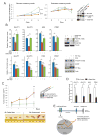EGFR mutation-induced alternative splicing of Max contributes to growth of glycolytic tumors in brain cancer
- PMID: 23707073
- PMCID: PMC3679227
- DOI: 10.1016/j.cmet.2013.04.013
EGFR mutation-induced alternative splicing of Max contributes to growth of glycolytic tumors in brain cancer
Abstract
Alternative splicing contributes to diverse aspects of cancer pathogenesis including altered cellular metabolism, but the specificity of the process or its consequences are not well understood. We characterized genome-wide alternative splicing induced by the activating EGFRvIII mutation in glioblastoma (GBM). EGFRvIII upregulates the heterogeneous nuclear ribonucleoprotein (hnRNP) A1 splicing factor, promoting glycolytic gene expression and conferring significantly shorter survival in patients. HnRNPA1 promotes splicing of a transcript encoding the Myc-interacting partner Max, generating Delta Max, an enhancer of Myc-dependent transformation. Delta Max, but not full-length Max, rescues Myc-dependent glycolytic gene expression upon induced EGFRvIII loss, and correlates with hnRNPA1 expression and downstream Myc-dependent gene transcription in patients. Finally, Delta Max is shown to promote glioma cell proliferation in vitro and augment EGFRvIII expressing GBM growth in vivo. These results demonstrate an important role for alternative splicing in GBM and identify Delta Max as a mediator of Myc-dependent tumor cell metabolism.
Copyright © 2013 Elsevier Inc. All rights reserved.
Figures




References
-
- Blackwood EM, Eisenman RN. Max: a helix-loop-helix zipper protein that forms a sequence-specific DNA-binding complex with Myc. Science. 1991;251(4998):1211–1217. - PubMed
-
- Christofk HR, Vander Heiden MG, et al. The M2 splice isoform of pyruvate kinase is important for cancer metabolism and tumour growth. Nature. 2008;452(7184):230–233. - PubMed
-
- Christofk HR, Vander Heiden MG, et al. Pyruvate kinase M2 is a phosphotyrosine-binding protein. Nature. 2008;452(7184):181–186. - PubMed
Publication types
MeSH terms
Substances
Associated data
- Actions
Grants and funding
LinkOut - more resources
Full Text Sources
Other Literature Sources
Molecular Biology Databases
Research Materials
Miscellaneous

